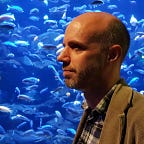‘Top Hat’ or — Charmed Particles?
When I discovered that the director of ‘Top Hat’s (1935), Mark Sandrich, background was in engineering and physics I immediately thought “Well, that explains a lot!” as I hadn’t been too sure if I’d been watching a couple of human beings for the last 100 minutes or two subatomic particles creating arcing patterns inside a bubble chamber. My hunch is it was the latter.
Fred and Ginger fall in love with each other. Fred is a force that can’t stop moving and Ginger knows to play along for the thrill of unexpected acceleration. Yet Ginger thinks Fred is married, and married to one of her best friends no less. But Fred isn’t married. This is because he exists purely in a realm where the only forces are centrifugal and rotational. He also appears to have his own personal orchestra just off-screen.
So ‘Top Hat’ is a mistaken identity movie, although exactly what is being mistaken here as the gender and sexuality is as fluid as the dance steps? Jerry (Fred) and Horace (Edward Horton) share the bridal suite together and nobody bats an eyelid, whilst Horace’s wife (the excellent Helen Broderick) comes across as so sexually liberal that I wouldn’t have been surprised if she suggested that at the film’s climax everyone celebrates by throwing their keys in a bowl. And notice Alberto Beddini’s favourite declaration — “For the man, the sword!” — and ask yourself exactly what sword he has in mind for all these men? There’s sex here but it’s refreshingly uncoupled from the stuffy restrictions of tradition.
There’s also an almost abstract homoeroticism running throughout ‘Top Hat’. The title number itself is not only a fantastic example of style, execution and syncopation (and featuring some modern angular movements prefiguring Fosse) but also a remarkable illustration of male silhouetted solipsism as Fred dances alone, accompanied only by simulacrums of himself which he quickly guns down lest they intrude on his tap-dancing solitude.
Yet none of this really matters because for all the declarations of love and romance ‘Top Hat’ is not a musical where dancing is an expression of love or who ends up with whom, but where dancing IS love. It is the moving, not Ginger, that consumes Astaire’s entire self as the two dance together. Besides, Ginger’s seems to be an actual human being and you can sense the thrill, and possibly hidden pain, inside her yet Fred is such an otherworldly presence who almost transcends physical sexuality that she might as well be dancing with the monolith from ‘2001: A Space Odyssey’ (1968). And that’s not just a flippant comparison as Astaire is essentially a pitch-black entity existing on an abstract plane that communicates by emitting a series of ear-splitting, high frequency signals.
The songs are by Irving Berlin and they’re delightful, although I was more impressed by the orchestration so I’m curious to discover just how much Max Steiner, the musical director, was responsible for the overall ecstatic effect at play here (I suspect it was a lot). And even though the plot is slight, ludicrous and unoriginal it’s deceptively smart, often throwing up some real surprises and clever word play. There’s even a Gertrude Stein joke here and it’s a good one, and I was also very fond of Baddini’s accusation to Ginger “You were cahooting with him!”
I used the word “ecstatic” in the previous paragraph and that’s accurate because ‘Top Hat’ does achieve passages of sublime bliss, specifically in the climactic number, The Piccolino. It’s initially performed by the chorus until they drop out and, in one of the most beautiful camera moves I’ve ever seen, Fred and Ginger take to the floor. Steiner augments the lightness of these movements by briefly reducing the orchestration to almost nothing but piano and harp which creates an almost anti-gravitational effect, a sort of sonic glitter over everything, as well as providing a nice dynamic contrast for when the beefier instruments kick in like rocket fuel.
It’s all performed in one incredible take, the camera (and hence us) moving with the dancers with a precision that’s flawless and transfixing. Fred and Ginger are incredible together during the piece but, and this isn’t a mark against Rogers at all, I couldn’t keep my eyes off Astaire and what he was doing, how he was driving it all. After all, Ginger is human, made of flesh and blood. This means we can relate to her. We can feel her combined aches and wonder. He’s on another level altogether, propelling the audience through his dazzling star gate as he keeps transmitting his continuous high-frequency signals into the depths of space.
